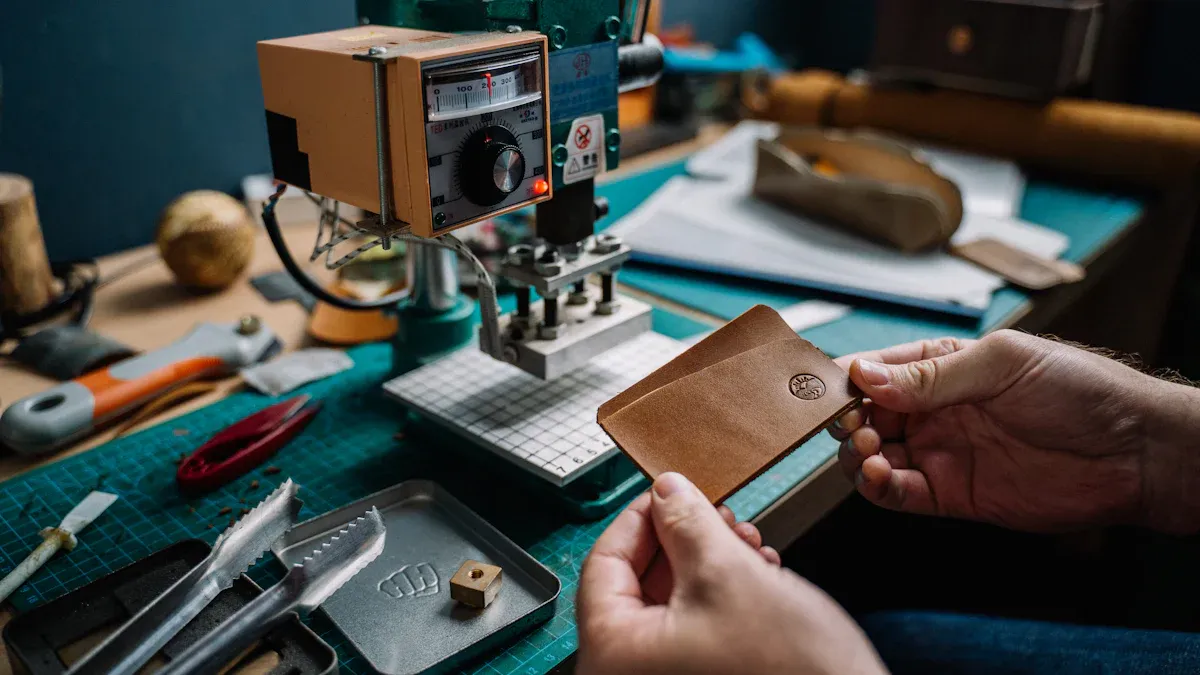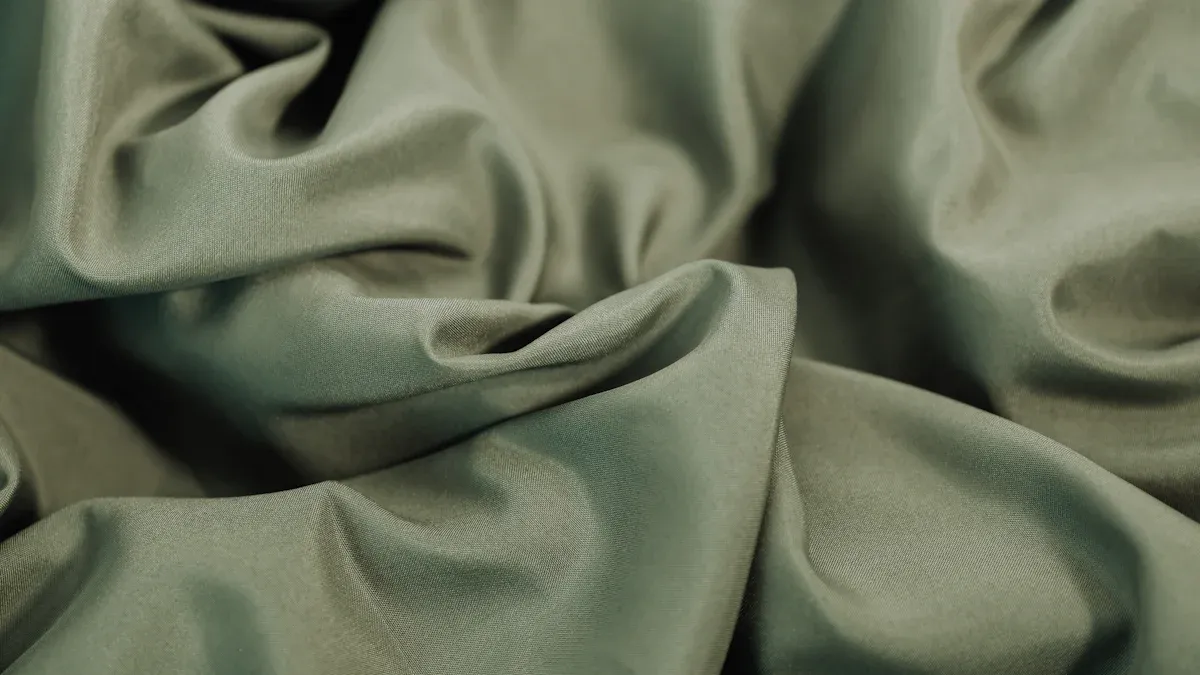
Double Face Scuba Fabric offers a unique experience for makers who value versatility and modern design.
- Its dual-sided construction allows creative freedom for both beginners and advanced sewists.
- Many enjoy the luxurious feel and eye-catching finish that this material brings to every project.
Key Takeaways
- Double Face Scuba Fabric offers two different sides, allowing makers to create reversible and visually striking projects without extra lining.
- This fabric holds shape well, stretches comfortably, and resists wrinkles, making it ideal for a wide range of fashion, accessories, and home décor projects.
- Beginners can start with easy projects like tote bags and headbands, while advanced sewists can explore structured garments and sculptural art using recommended tools and sewing techniques.
10 Double Face Scuba Fabric Projects for All Skill Levels
Reversible Tote Bag
A reversible tote bag showcases the dual-sided nature of Double Face Scuba Fabric. Makers can select contrasting colors or textures for each side, creating a versatile accessory. The fabric’s structure supports the bag’s shape, while its stretch allows for easy turning and finishing. This project suits beginners and offers a practical introduction to working with this material.
Structured Skater Skirt
A skater skirt made from Double Face Scuba Fabric holds its shape beautifully. The fabric’s body and drape create a flattering silhouette. Sewists can experiment with exposed seams or let the contrasting sides peek through pleats. This project helps intermediate makers practice sewing curves and attaching waistbands.
Modern Throw Pillow Covers
Modern throw pillow covers add a pop of color and texture to any room. Double Face Scuba Fabric resists wrinkles, making it ideal for home décor. Makers can use envelope closures or invisible zippers. Mixing and matching the two sides of the fabric creates bold, geometric designs.
Tip: Use a rotary cutter for crisp, clean edges when cutting pillow panels.
Statement Headbands
Statement headbands crafted from this fabric offer both comfort and style. The stretch ensures a snug fit, while the thickness provides structure for bows or knots. Makers can sew or glue the fabric, making this project accessible to all skill levels.
Color-Blocked Sweatshirt
A color-blocked sweatshirt highlights the unique properties of Double Face Scuba Fabric. By combining panels from both sides, sewists achieve a modern, sporty look. The fabric’s warmth and flexibility make it perfect for casual wear. This project introduces techniques like attaching ribbing and sewing with stretch stitches.
Tech Organizer Pouch
A tech organizer pouch keeps cables, chargers, and devices secure. The fabric’s thickness offers protection without bulk. Makers can add pockets, zippers, or elastic loops. This project encourages creativity in layout and design, appealing to both beginners and advanced sewists.
Sculptural Wall Art
Sculptural wall art transforms Double Face Scuba Fabric into a statement piece. The material’s structure allows for folding, pleating, or layering. Makers can mount the fabric on canvas or embroidery hoops. This project invites experimentation with shapes and color contrasts.
Simple Fit-and-Flare Dress
A fit-and-flare dress made from this fabric flatters many body types. The stretch ensures comfort, while the structure maintains the dress’s shape. Sewists can play with reversible elements, such as cuffs or collars. This project builds confidence in garment construction.
Tablet or Laptop Sleeve
A tablet or laptop sleeve protects devices with style. Double Face Scuba Fabric cushions electronics and resists wrinkles. Makers can add closures like Velcro, snaps, or zippers. The dual-sided design allows for a pop of color inside or out.
No-Sew Infinity Scarf
A no-sew infinity scarf offers a quick, fashionable accessory. Makers simply cut a length of fabric, twist, and join the ends. The fabric’s clean edges do not fray, so sewing is optional. This project is perfect for beginners or anyone seeking instant results.
Double Face Scuba Fabric: Unique Properties and Benefits

Dual-Sided Design and Texture
Double Face Scuba Fabric features two distinct surfaces. Each side often displays a different color or texture. This dual-sided construction gives designers more creative options. They can highlight contrasting shades or combine matte and shiny finishes in one project. Many makers appreciate the ability to create reversible items or add visual interest without extra layers.
Note: The dual-sided nature reduces the need for lining, saving both time and materials.
Structure, Stretch, and Wrinkle Resistance
This fabric stands out for its impressive structure. It holds shapes well, making it ideal for projects that require volume or crisp lines. The material also offers a comfortable stretch, which allows for easy movement in garments. Wrinkle resistance ensures that finished pieces look polished even after frequent use. These qualities make Double Face Scuba Fabric a favorite for both apparel and accessories.
Ideal Uses for Creative Projects
Double Face Scuba Fabric adapts to a wide range of creative projects. Designers use it for fashion items like skirts, dresses, and sweatshirts. Home décor projects, such as pillow covers and wall art, benefit from its durability and bold appearance. The fabric’s thickness provides protection for tech sleeves and pouches. Its versatility encourages experimentation and innovation in sewing.
Project Tips for Double Face Scuba Fabric
Skill Level Guidance for Each Project
Every project offers unique challenges and learning opportunities. Beginners often find success with accessories like headbands, infinity scarves, or simple tote bags. These projects require minimal shaping and allow makers to focus on basic cutting and joining techniques. Intermediate sewists can explore structured skirts, sweatshirts, or pillow covers, which introduce curved seams and more precise construction. Advanced makers may enjoy sculptural wall art or fit-and-flare dresses, where mastery of shaping and finishing techniques becomes essential.
Key Considerations When Sewing
Proper preparation and technique ensure professional results and fabric longevity.
1. Use a stretch needle with a deep shaft and rounded point to prevent skipped stitches and fabric damage. 2. Avoid pins in garment areas; opt for pattern weights to manage bulky layers and prevent snags. 3. Employ stretch or triple straight stitches with a slightly longer stitch length to accommodate fabric stretch and bulk. 4. Utilize a roller or walking foot for even feeding of slippery, bulky layers. 5. Select pattern sizes based on body measurements, as scuba fabric fits differently than standard sizes. 6. Choose patterns designed for two-way stretch fabrics; match fabric stretch behavior to pattern type. 7. For woven patterns with stretch scuba, consider smaller sizes and omit fastenings like zippers. 8. Avoid neat stitched pleats due to fabric springiness; opt for dramatic drapes, full skirts, and bold collars. 9. Raw edges do not require finishing, as scuba does not fray; overlocking or bias binding remains optional. 10. For thick scuba fabrics, trim seams before overlocking and use a three-thread overlocker with the knife disengaged.
Experimental studies show that sewing techniques directly affect the performance of projects, especially in applications requiring water resistance. Stitching can pierce the fabric and alter its behavior, but post-stitch treatments, such as water-repellent wax, can restore and even enhance fabric properties.
Creative Variations and Design Ideas
| Project Type | Variation Ideas | Design Tips |
|---|---|---|
| Tote Bags | Add pockets, use color blocking | Highlight both fabric sides |
| Skater Skirts | Insert contrast panels, try pleats | Use bold collars or dramatic drape |
| Wall Art | Layer shapes, mix textures | Mount on hoops or canvas |
| Tech Sleeves | Add closures, personalize with patches | Use bright linings for contrast |
Makers can experiment with reversible elements, exposed seams, or bold geometric shapes to showcase the fabric’s dual-sided nature.
Sewing Tips for Double Face Scuba Fabric
Recommended Tools and Notions
Sewists achieve the best results with the right tools. A stretch needle (size 75/11 or 90/14) prevents skipped stitches and fabric damage. A walking foot or roller foot helps feed thick layers evenly. Pattern weights replace pins to avoid leaving marks. Sharp fabric scissors or a rotary cutter ensure clean, precise cuts. Clips work better than pins for holding layers together.
Tip: Use polyester thread for strong, flexible seams.
Best Stitches and Techniques
Stretch stitches work well with this fabric. A narrow zigzag or triple straight stitch allows seams to stretch without breaking. For seams that need extra strength, a serger creates a professional finish. Sewists should test stitch settings on a scrap before starting the project. Topstitching adds structure and keeps seams flat.
| Stitch Type | Use Case | Notes |
|---|---|---|
| Zigzag | Seams, hems | Allows stretch |
| Triple straight | High-stress seams | Extra durability |
| Overlock/Serger | Seam finishing | Clean, professional look |
Finishing and Care Tips
Raw edges do not fray, so finishing is optional. If a clean look is desired, a serged or bound edge works well. Press seams with a cool iron and a pressing cloth to avoid shine. Machine wash garments in cold water and lay flat to dry. Avoid high heat in the dryer, as it can damage the fabric’s structure.
Note: Store finished projects flat or hanging to maintain their shape.
Double Face Scuba Fabric inspires makers at every skill level. These ten projects highlight its versatility and unique qualities. Makers can start a new project today and explore even more creative ideas. For further inspiration, they can review linked patterns and resources.
Creativity thrives with the right materials.
FAQ
What sewing machine needle works best for double face scuba fabric?
A stretch needle, size 75/11 or 90/14, prevents skipped stitches and fabric damage. This needle type ensures smooth sewing and professional results.
Can beginners sew with double face scuba fabric?
Yes. Beginners can start with simple projects like headbands or tote bags. The fabric’s stability and non-fraying edges make it easy to handle.
How should makers care for double face scuba fabric projects?
Machine wash in cold water. Lay flat to dry. Avoid high heat. Store finished items flat or hanging to maintain their shape and structure.
Post time: Jul-01-2025